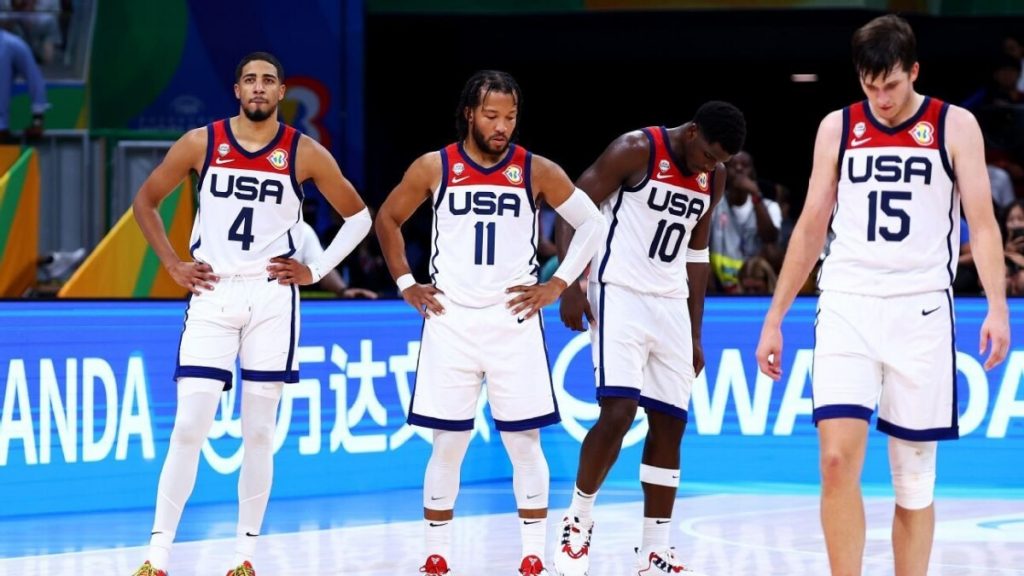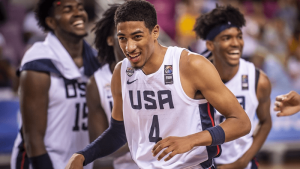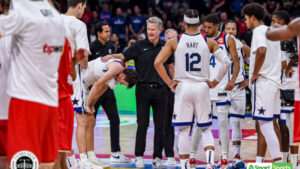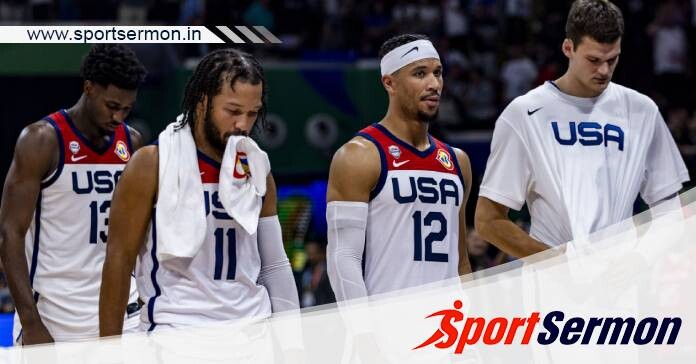USA Failed FIBA: After defeating Italy in the quarterfinals and rebounding from a defeat to Lithuania in group play, the United States lost two games that were close in the medal rounds of the 2023 FIBA World Cup. Team USA lost to eventual champion Germany 113-111 in a nail-biting semifinal on Friday, and Canada defeated the United States 127-118 in overtime on Sunday to claim bronze.
A little more than 10 months remain until the 2024 Paris Olympics final, and Team USA may look forward to fielding a more illustrious lineup on the floor (perhaps including LeBron James?). Nevertheless, USA Basketball’s leadership must take note of the harsh lessons offered by the team’s three defeats in this year’s World Cup if they hope to capture a fifth straight Olympic gold.
In order to better understand why this year’s team struggled in the Philippines and how they may prevent a repetition with more eyes on them next year in Paris, let’s break into the ugly data exposing the USA failed FIBA as well as the history of the USA in the professional era.
The reasons why Team USA failed FIBA World Cup 2023 are given below:
Still wins with star talent

There was a brief trend for USA Basketball to emphasise “fit” and choose more specialists rather than the ball-dominant stars who had made up previous teams after the USA lost to Great Britain in the 2004 Athens Olympics, the first time since NBA players were permitted to compete.
Tayshaun Prince’s selection in 2008 was a hint in that direction, but otherwise, the “Redeem Team” and its 2012 follow-up dominated opponents with Hall of Fame quality alone. Even if it’s not perfect, performance during the previous NBA season continues to be a reliable indicator of USA Basketball’s success.
Thus, it shouldn’t be shocking that this year’s World Cup team didn’t do well. Only the squad that represented the United States in the 2019 World Cup, which finished ninth, had fewer combined wins above replacement player (WARP) according to my statistics the season prior.
You might also be interested in reading this: Players that the USA should hold over from FIBA to the Olympics
USA Basketball Results With NBA Players
| YEAR | COMPETITION | WARP | ALL-STAR | ALL-NBA | RECORD | FINISH |
|---|---|---|---|---|---|---|
| 1996 | Olympics | 188.7 | 12 | 8 | 8-0 | Gold |
| 1992 | Olympics | 172.6 | 11 | 9 | 8-0 | Gold |
| 2008 | Olympics | 157.2 | 9 | 5 | 8-0 | Gold |
| 2006 | World Cup | 148.1 | 4 | 3 | 7-1 | Bronze |
| 2012 | Olympics | 143.0 | 9 | 6 | 8-0 | Gold |
| 1994 | World Cup | 130.6 | 6 | 2 | 8-0 | Gold |
| 2000 | Olympics | 126.8 | 7 | 4 | 8-0 | Gold |
| 2002 | World Cup | 126.2 | 4 | 0 | 6-3 | 6th |
| 2016 | Olympics | 121.8 | 9 | 7 | 8-0 | Gold |
| 2014 | World Cup | 110.3 | 5 | 2 | 9-0 | Gold |
| 2004 | Olympics | 105.9 | 2 | 1 | 5-3 | Bronze |
| 2010 | World Cup | 92.2 | 3 | 1 | 9-0 | Gold |
| 2021 | Olympics | 74.4 | 5 | 1 | 5-1 | Gold |
| 2023 | World Cup | 65.1 | 3 | 0 | 5-3 | 4th |
| 2019 | World Cup | 51.5 | 2 | 1 | 6-2 | 7th |
The most talented team in the competition was still Team USA. With only four active NBA players, none of whom were All-Stars, Germany advanced to the bronze-medal match in the quarterfinals before taking home the gold. However, the U.S. has generally had a significant lead due to how much more other national teams—with the noteworthy exception of Canada—benefit from experience with international regulations and consistency.
From that perspective, the USA’s roster for the next year should be stronger. Only in 2004, after the United States hosted the 2002 competition (then known as the World Championship), did the U.S. Olympic roster have fewer WARP than the previous World Cup squad. The American top athletes should experience something a lot closer in the Paris Games, and that could be enough to get them back on the podium.
Where was the defence?

The way the defence crumbled in Team USA’s three losses is the main cause for worry that talent alone won’t save it. The United States had the third-best defensive rating throughout the World Cup, surrendering an estimated 103.4 points for every 100 possessions.
The U.S. struggled to halt serious competitors while dominating outclassed adversaries, as this aggregate statistic conceals. The USA’s defensive rating in five victories was 83.2 points allowed per 100 possessions. That increased to a 136.7 defensive rating in three defeats. Germany’s projected offensive efficiency against the United States was 144 points per 100 possessions, which ranked seventh among all teams in any World Cup game.
Despite not having nearly as many chances to capitalise on turnovers and defensive rebounds, the USA offence was remarkably more effective in the three defeats than the five victories. However, the U.S. was unable to secure the required stops, thus it was still insufficient.
The USA’s defence failed on every level, but it was particularly notable for letting opponents shoot an effective 63% from the field after taking into account the added value of 3-pointers (up from 42% in victories) and rebounding just 62% of opponents missed attempts, which was far less than its winning percentage of 75%. Both of those problems indicate that the American roster lacks players of a functional size.
The small ball shrank in size.

It goes without saying that Team USA’s modest size was a problem while playing against the strong frontcourts of Germany and Lithuania, but I believe that the centre position has received too much emphasis. Based on the success of using Bam Adebayo and Draymond Green in switch-heavy lineups at centre during the 2020 Tokyo Olympics, the United States chose to use Jaren Jackson Jr., the reigning defensive player of the year, and Paolo Banchero, both of whom play power forward in the NBA. Jackson Jr. also regularly plays centre for the Memphis Grizzlies.
But it’s important to keep in mind that the USA’s “small-ball” lines during the Olympics frequently included 6-foot-10 Kevin Durant and frequently 6-8 Jayson Tatum. Only one player higher than 6-6 was in the starting lineup when Josh Hart (6-5) took over for the ineffectual Brandon Ingram at power forward, making Johnson and Ingram the USA’s two largest players at that position.
The perimeter player switching on to a big when the USA switched pick-and-rolls generally had a significant size disadvantage, requiring the USA to front the post or send double-team help. As a result, against fronts and double teams, there were open looks and chances on the offensive boards. Tyrese Haliburton, a 6-5 point guard, outperformed 6-2 Jalen Brunson for the U.S. during the medal rounds. With Haliburton at the point, the USA defeated Germany and Canada by a combined total of 24 points but was destroyed by 36 in Brunson’s minutes, leaving the team with a deficit they were unable to recover.
The U.S. would benefit on the defensive boards from having more size on the perimeter. Adebayo, Durant, Green, and Tatum were the four members of the 2021 rotation who secured at least 20% of the available defensive rebounds in the previous year. Only Hart met that bar among the 2023 regulars. While no player on the 2021 roster outperformed Brunson, Haliburton, and Austin Reaves in terms of defensive rebounding, they all did.
This lesson may potentially be more important in 2027 when Qatar hosts the World Cup. When Durant and Tatum are contenders for another Olympic gold medal next summer, USA Basketball will have a lot more alternatives for size on the wings. To avoid a repetition of the previous two World Cups, the U.S. will need to be more choosy when the pool is smaller.
These are the reasons why Team USA failed FIBA World Cup 2023. Let us know your thoughts in the comment section below.

